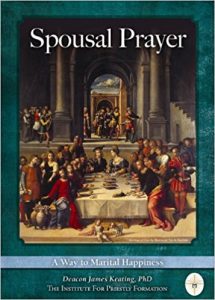Spousal Prayer: A Way to Marital Happiness
by Deacon James Keating
 When you hear the words “spousal prayer,” what comes to mind? For some, it may conjure up images of husband and wife sitting somewhat awkwardly on the couch, wondering how praying together is supposed to “work” and worrying that they’re doing it wrong. Or it could bring to mind the routine, comfortable prayers of daily life: prayers around the dinner table, prayers at bedtime, and prayers before big decisions. Or perhaps the words merely draw a blank.
When you hear the words “spousal prayer,” what comes to mind? For some, it may conjure up images of husband and wife sitting somewhat awkwardly on the couch, wondering how praying together is supposed to “work” and worrying that they’re doing it wrong. Or it could bring to mind the routine, comfortable prayers of daily life: prayers around the dinner table, prayers at bedtime, and prayers before big decisions. Or perhaps the words merely draw a blank.
Have you ever thought of prayer – especially spousal prayer (prayer with one’s spouse) – in terms of intimacy? In his book Spousal Prayer: A Way to Marital Happiness, Deacon James Keating makes the case that prayer “is the most intimate experience a couple can share” (p. 21, emphasis original).
That thought alone is striking, and goes a long way in explaining Keating’s insistence that couples devote time to praying together and develop a prayer life as a couple.
But how? Keating acknowledges that many couples desire to pray together, but simply don’t know how. His book seeks to meet that need.
Interestingly, Keating spends about a third of his short (54 pp) book helping couples lay the groundwork for spousal prayer. And because prayer is a form of intimacy, this groundwork is also preparation for intimacy in general and, as we’ll see, for intimacy with God.
Keating’s first prerequisite for spousal prayer is to “behold” the other spouse. “To behold,” he says, is not just a matter of looking at one’s spouse, but “means that you allow your spouse’s heart, your spouse’s identity, to be received at the deepest level of your being” (p. 13). In other words, “beholding” your spouse means seeking to discover anew the beautiful gift of God’s creation that your spouse is.
The next prerequisite for spousal prayer is listening to one’s spouse. Now, spouses listen to each other frequently throughout the day, with more or less attention. But Keating is talking about something deeper. Just as “beholding” is more than looking at one’s spouse, so too “listening” for him is more than just hearing what one’s spouse says. He wants spouses to listen to each other “at the deepest level”: to receive what your spouse says as a gift of his or her self, and to receive it into your own heart.
The final prerequisite for prayer is forgiving one’s spouse. Keating spends some time talking about what forgiveness is and how spouses can seek healing from each other and from Christ when one of them has been wounded by the other. (What married couple has not experienced that painful event?) Holding a grudge – refusing to forgive – can of course prevent spouses from achieving true intimacy. In contrast, seeking and offering forgiveness, and accepting God’s healing for the wounds a spouse inflicts, lay the groundwork for stable, lasting intimacy.
Only after laying the foundations of spousal prayer – beholding, listening, forgiving – does Keating talk about prayer directly.
Refreshingly, he acknowledges that prayer can be hard, especially when one is not used to it: “Failure in prayer is to be expected and welcomed,” he writes, because “failure” (the sense of not doing prayer right) reminds us that prayer is not about mastering a skill but about being with God and receiving His presence and love (p. 26, emphasis original).
But even though prayer, at its heart, is not about mastering a skill, couples will benefit from reflecting on Keating’s description of what spousal prayer can look like. Here, he reprises his first section on preparation for prayer. Prayer, he says, is a matter of beholding God, listening to Him, and repenting in order to receive His forgiveness. The parallel is clear: intimacy with God relies on the same principles as intimacy with one’s spouse. Behold – Listen – Repent. This “model” of prayer can give couples a place to begin in learning to pray together, that is, to be in God’s presence together and to receive Him into their lives as a couple.
Keating offers several other practical tips for couples who want to pray together: Be willing to compromise on your preferred “method” of prayer (Scripture reading, Rosary, etc.) and try praying in the way your spouse finds most comfortable; place sacred images in your home and spend time together simply looking at a Crucifix or at images of Jesus; finally, and most helpfully, ask the Holy Spirit for help! “When you are weak, tired, frustrated, frightened, just yield to Him, and let Him pray in you” (p. 31).
Keating’s concluding chapter is a very brief reflection on “Staying in love.” Beholding, listening, and forgiving/repenting – these are ways to stay in love with one’s spouse and with God. And the more one is in love, the more one’s actions and decisions will be infused with this love.
In an appendix to the book, Keating answers frequently asked questions about prayer, including how to know when one is hearing God in one’s prayer instead of one’s own voice – a common concern!
Overall, Spousal Prayer contains rich veins of wisdom for the married couple who wants to begin or enrich their prayer life together. Because many couples may have lacked a model for spousal prayer in their families of origin, Keating serves as a trustworthy guide. The parallel he draws between spousal intimacy and intimacy with God is especially valuable, as it provides a fruitful way for spouses to understand how their faith enriches their marriage and vice versa.
There are sections of Spousal Prayer where Keating uses terms that may be unfamiliar to the average reader, or uses terms in surprising ways that may be initially difficult to understand. At times, some terms in the book could have been explained earlier and more clearly. But notwithstanding this potential hurdle, readers willing to sit with this short book and ponder its meaning for their own marriage and spousal prayer life should find a way to grow closer to their spouse and to God.
To order copies of Spousal Prayer: A Way to Marital Happiness, contact 800.932.3051 or team@catholicword.com. Bulk discounts and parish billing are available.
About the reviewer
Bethany Meola is Assistant Director of USCCB Secretariat of Laity, Marriage, Family Life and Youth and content editor of the For Your Marriage website
Disclaimer: Book reviews do not imply and are not to be used as official endorsement by the USCCB of the work or those associated with the work. Book reviews are solely intended as a resource regarding publications that might be of interest to For Your Marriage visitors.




